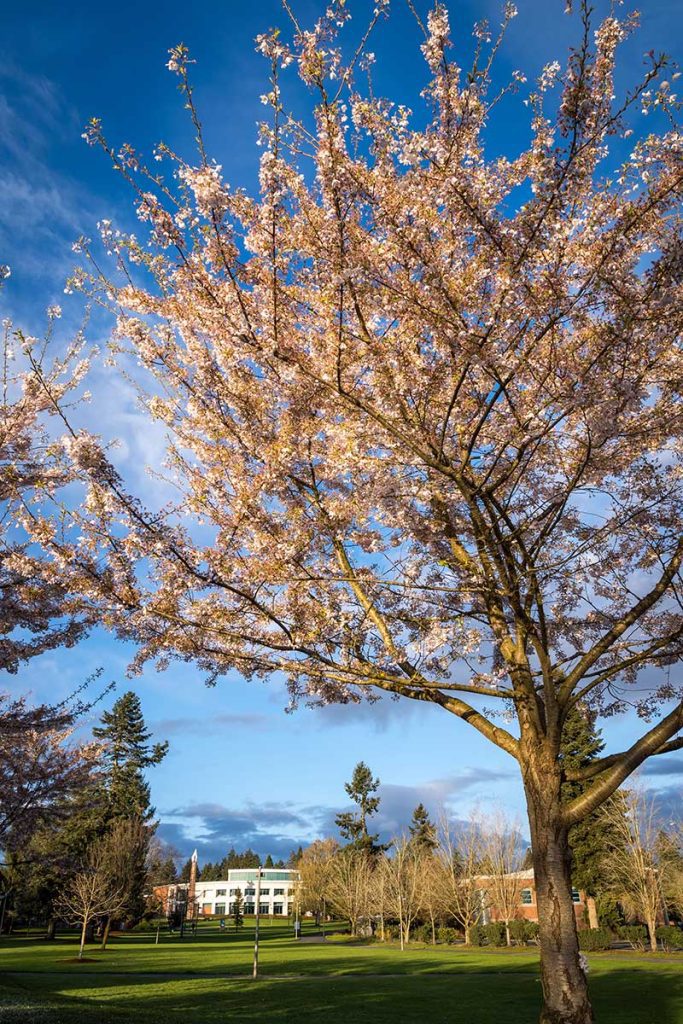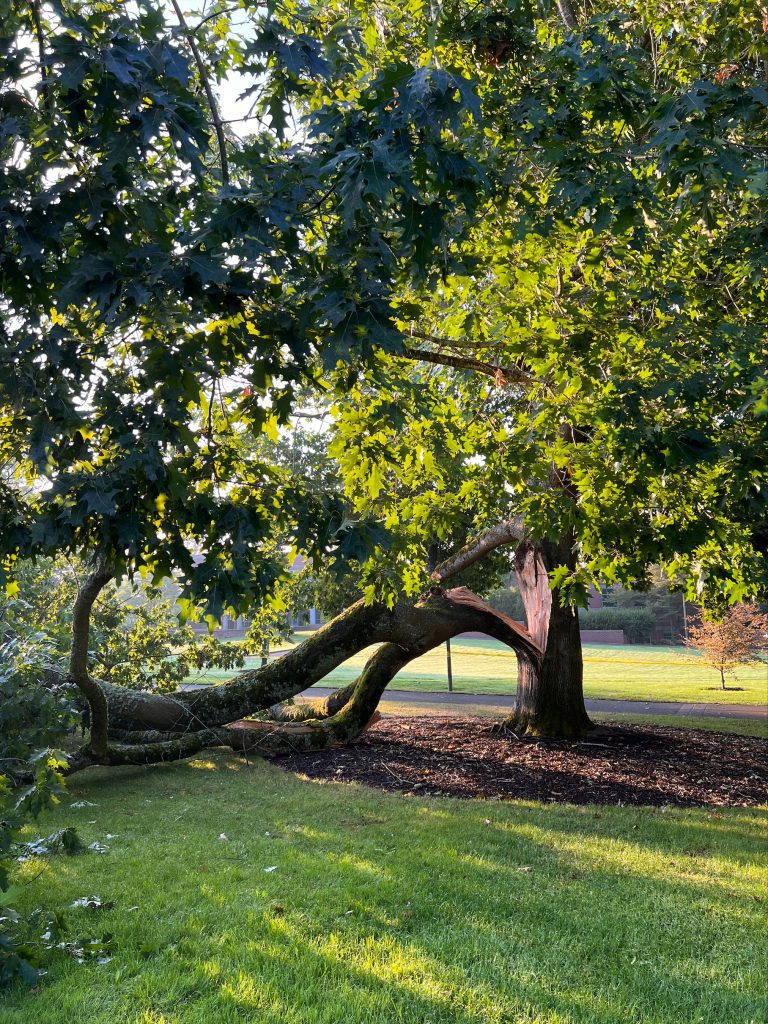History is rooted in Clark
Clark’s campus is a 90-acre arboretum
4-minute read
Clark College is not just a place of higher education, it’s also a 90-acre arboretum. Some trees on campus have identifying plaques or tags around their trunks. Every tree has a story.
John Kageyama, president of America Kotobuki Electronics, Inc., presented 100 Shirofugen cherry trees to the City of Vancouver in 1990 to commemorate the 100th anniversary of Washington’s statehood. They were planted on Clark’s campus to honor the friendship between Vancouver and its sister city, Joyo, Japan. All those trees provide a showy pink backdrop to Clark’s annual Sakura festival and many photos.

Clark’s campus is adorned by more than 200 Shirofugen cherry trees, thanks to a gift from the late John Kageyama, former president of America Kotobuki Electronics. Photo by Jenny Shadley
Clark’s campus houses the state tree—or a close relative that is suited for Vancouver’s climate—for 48 of the nation’s 50 states. The state tree project was formally proposed by Skip Jimerson, a longtime grounds manager, now retired. But the informal initiative probably dates to former biology professor Anna Pechanec, the namesake of one of Clark’s science buildings.
Pechanec is believed to have planted many of Clark’s trees. At night. Without permission.
Guerilla planting
Jerry Franklin ’55 studied under Pechanec and said she had a profound influence on his career. Franklin went on to become a world-renowned forest ecologist whose research helped spark the Pacific Northwest timber wars over old growth logging and its effects on the northern spotted owl.
Franklin didn’t help Pechanec plant trees. He attended Clark before most classes were moved to the current 101-acre Vancouver Central Park location. But Franklin said he’s not surprised to learn of Pechanec’s guerilla planting operation.
“I could believe that she might do some unscheduled planting,” Franklin said.
Franklin said he’s also not surprised that Pechanec planted a wide array of trees that are not normally found in Southwest Washington.
“As someone who’s teaching, that gives her a resource,” Franklin said. “She can take her students right out the door and go around and show them … identification. And when she needed fresh material for them to look at, she had it right there.”
Clark’s treescape continues to grow and change. In October 2022, a beloved Oregon white oak near the southeast corner of Foster Hall was damaged in a storm and had to be cut down. The tree was thought to have been planted in the 1970s, perhaps by Pechanec.
Dr. Steven Clark, a Clark biology professor, said trees are biological philanthropists, supporting a variety of species from insects to birds to mosses. Just as the campus is home to Clark’s community, each tree is home to another, smaller community Researchers have counted the number of living species known to have mutualistic relationships with different varieties of trees.
Biological philanthropists
“There is no plant in the Pacific Northwest that offers more habitat value than Oregon oak,” Clark said.
Insects lay eggs on leaves, birds’ nest in trunk cavities and mammals feast on acorns. Clark said he was heartened by the community response to news that the oak tree was being removed.

An Oregon white oak near the SE corner of Foster Hall was damaged in a storm in 2022 and was cut down. Portions of the tree will be used as nesting habitat for bees as part of a new project to support pollinator populations. Photo by Wei Zhuang
“People were aware that even though the tree was damaged, it still had ecological value,” he said.
The tree is not going to waste. Smaller branches were chipped and used to mulch areas on campus. Larger limbs will be used in a new project set to debut in May.
Clark—the professor—is working to turn Clark—the campus—into a certified Bee Campus USA by planting patches of native wildflowers for food and strategically placing hardwood limbs for nesting habitat. By summer, Clark’s campus could be an arboretum and a sanctuary for bees.
Bees a buzzin’
Students will conduct bee surveys to track changes to pollinator populations. Bees have been declining globally, threatening agricultural production. By summer, Clark’s campus could be an arboretum and a sanctuary for bees.
Clark said he expects the project will produce big—and fast—results.
“Killer whales, for example, are also in decline. But female killer whales have one baby every five years. So it would take a very long time to see any real (rebound) in population,” he said.
Bees, on the other hand, reproduce quickly. Flowers planted in February could help a female bee produce 15 offspring instead of the eight she had last year.
“We’re going to have orders of magnitude difference in one year,” Clark said.
Most native bees are solitary and nest on the ground or in hardwood—such as the Oregon oak.
Written by Lily Raff McCaulou



